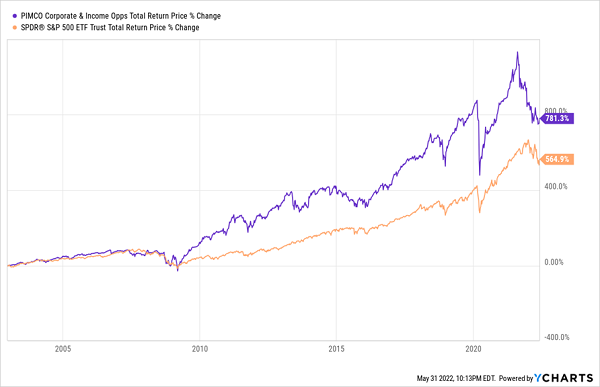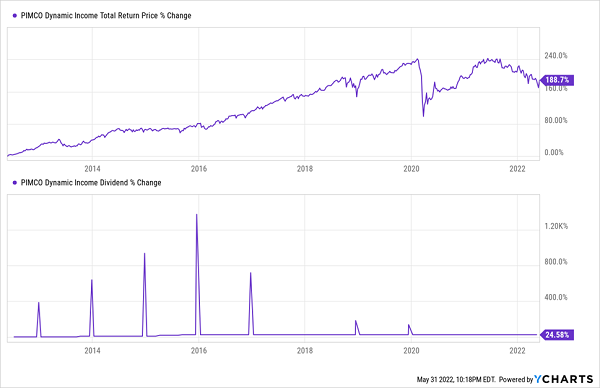When markets are down, there’s one group of investors who can shrug off the dip because they don’t need to sell. You’re no doubt part of this group—I’m talking about income investors.
With dividends, of course, you can keep your cash flow going regardless of short-term panics over things like interest-rate hikes and geopolitical unrest. Because the cash keeps coming in, you don’t need to sell during these times and can instead use your dividends to keep your bills paid—or maybe even buy the dip in the markets, thereby building your income stream further.
But where can you get reliable income that won’t be hit by the Fed’s moves and other events that are mostly beyond our control? Good news: there are some bond-focused closed-end funds (CEFs) that can invest alongside the Fed’s moves to keep your income strong while protecting your investment.
One strategy these funds use is to sell long-duration bonds and buy shorter-duration ones instead. Because shorter-duration bonds are less affected by rising rates, they don’t necessarily fall in price when the Fed hikes rates, as long-duration bonds typically do.
Long-Term Bonds Get the Flu, Short-Term Bonds Get the Sniffles

Of course, this is the most basic strategy, and the pro CEF managers will do a lot more to keep your dividend income rolling out and avoid losses triggered by the Fed’s actions. They often use a mix of derivatives and private contracts with banks, for example, to help stabilize their asset values because these tools give funds access to hedges they can use to protect themselves from major market downturns—hedges that aren’t available to the average investor.
And that income can be massive: with over 10% yields, on average, the three CEFs I’m about to show you are delivering big income streams to investors while aiming to keep a lid on volatility.
Each of these funds has something in common, as well: they’re managed by PIMCO, one of the world’s largest bond-investment firms, with a strong reputation on Wall Street and over $2 trillion under management. The firm also has a record of strong performance, as we can see in the returns delivered by our first pick, the PIMCO Corporate & Income Opportunity Fund (PTY).
Bond Fund Does Something It Isn’t Supposed To … Crush Stocks

As you can see, PTY has returned 781% since inception, as of this writing, while also crushing the stock market. That means PTY investors aren’t just doing better than those sticking their savings in the stock market—they’re also getting a huge yield that few, if any, stocks can provide over the long term.
Funny thing is, with a 9.8% yield, PTY is actually the lowest-yielding fund I’m going to show you today! In part, that’s because its strategy is relatively more conservative than that of my second pick, the PIMCO Dynamic Income Fund (PDI), which uses a mix of bonds and bond derivatives to deliver an 11.7% income stream.
Big Profits and Surprise Payouts, Too?

Worried those derivatives could harm PDI? Don’t be. Not only did PDI survive the COVID-19 selloff in 2020, but it kept payouts steady throughout the crisis and, as you can see from the chart above, has actually hiked its dividend over the long term. A growing 11.7%-yielding dividend shouldn’t be possible, but that’s what PDI has been delivering for nearly a decade.
And that’s not all. See those spikes? Those are special payouts at times when the market surprised with bigger gains, and it’s no surprise those all came in the early 2010s. At the time, PDI was aggressively investing in the mortgage-bond market, which investors had foolishly written off as too risky because of the 2008/’09 subprime-mortgage crisis.
PIMCO’s managers, ever the wise contrarians, took an old Wall Street adage to heart: the next crisis will not be the same as the last one. Avoiding recency bias, they bought great bonds priced at discounts and provided a huge income stream to investors. They’re poised to pull off that feat this decade, as well, as the fund is positioning itself through its derivative investments to profit from inflation, not be scared of it like so many stock traders are.
Our final fund is the PIMCO High Income Fund (PHK). As the name suggests, PHK focuses on high-yielding corporate bonds using PIMCO’s deep knowledge of the corporate landscape to buy bonds that are oversold because of unfounded fears.
I like to think of PHK as a deep-value play. Check out this chart:
Investors Ignore PHK’s Bond-Picking Record

Over the last three years, PHK has seen a modest profit from its net asset value (NAV, or the value of its bond holdings; shown in orange) and again weathered the COVID-19 storm. The market hasn’t recognized this, though, pricing shares in PHK (shown in purple) lower than the increases to its portfolio.
That disconnect between market price and NAV can’t last forever, which is why I see an opportunity to buy PHK shares cheap to sell in the future, when the market realizes its mistake. Until that happens, PHK will pay us its dividend (current annualized yield: 10%) monthly.
My 4 Top CEFs Are Built for Volatile Markets (and Pay Monthly Dividends Yielding 8.5%)
Right now, I’m recommending 4 CEFs trading at such big discounts that I fully expect them to do the following:
- Rise 20% in one year if the market bounces from here, as their ridiculous discounts vanish, or
- Hold their own in a flat or falling market, again, thanks to those wide discounts.
Either way, we’ll collect their 8.5% dividends while we wait—and all four of these unsung income funds pay dividends monthly!
I’m ready to share my research on these funds with you now, as well as my full CEF-trading strategy, which I’ve custom-built for panicky markets like today’s. Click here to learn more, and get instant access to the names, tickers and my research on these 4 high-yielding—and monthly paying—CEFs.
